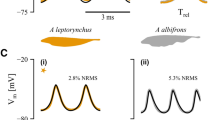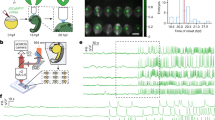Abstract
SINCE the equations describing the nerve action potential were formulated by Hodgkin and Huxley1, the range of phenomena to which they have been shown to apply has been greatly extended. Huxley2has applied them to the influence of temperature on the propagated response and to the repetitive firing observed in low calcium concentrations. More recently, Fitzhugh3 has shown that the long action potentials induced by tetraethylammonium ions in squid nerve may also be reproduced.
This is a preview of subscription content, access via your institution
Access options
Subscribe to this journal
Receive 51 print issues and online access
$199.00 per year
only $3.90 per issue
Buy this article
- Purchase on Springer Link
- Instant access to full article PDF
Prices may be subject to local taxes which are calculated during checkout
Similar content being viewed by others
References
Hodgkin, A. L., and Huxley, A. F., J. Physiol., 117, 500 (1952).
Huxley, A. F., Ann. N.Y. Acad. Sci., 81, 221 (1959).
Fitzhugh, R., J. Gen. Physiol., 43, 867 (1960).
Weidmann, S., J. Physiol., 127, 213 (1955); “Elektrophysiologie der Herzmuskelfaser” (Hans Huber, Berne and Stuttgart, 1956).
Hutter, O. F., and Noble, D. (preceding communication).
Noble, D., J. Physiol., Proceedings of the Physiological Society, September Meeting (1960).
Author information
Authors and Affiliations
Rights and permissions
About this article
Cite this article
NOBLE, D. Cardiac Action and Pacemaker Potentials based on the Hodgkin-Huxley Equations. Nature 188, 495–497 (1960). https://doi.org/10.1038/188495b0
Issue Date:
DOI: https://doi.org/10.1038/188495b0
This article is cited by
-
Coexistence of Attractors and Its Control with Selection of a Desired Attractor in a Model of Extended Hindmarsh–Rose Neuron with Nonlinear Smooth Fitting Function: Microcontroller Implementation
Journal of Vibration Engineering & Technologies (2022)
-
The Illusions of the Modern Synthesis
Biosemiotics (2021)
-
Electrophysiological insights into the relationship between calcium dynamics and cardiomyocyte beating function in chronic hemodialysis treatment
Journal of Artificial Organs (2021)
-
Mathematical model of the ventricular action potential and effects of isoproterenol-induced cardiac hypertrophy in rats
European Biophysics Journal (2020)
-
Mechanical regulation of gene expression in cardiac myocytes and fibroblasts
Nature Reviews Cardiology (2019)
Comments
By submitting a comment you agree to abide by our Terms and Community Guidelines. If you find something abusive or that does not comply with our terms or guidelines please flag it as inappropriate.



